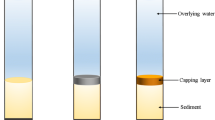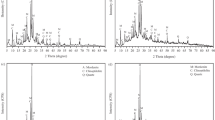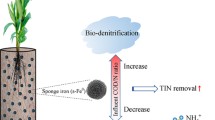Abstract
Purpose
Zeolite has been increasingly used as a capping material to remove nitrogen (N) and phosphorus (P) released from sediments into the overlying water. However, its removal efficiency varies because of the discrepancy of zeolite types. In this study, the iron-modification carbon/zeolite (MCZ) was synthesized and employed as a capping material to control dissolved oxygen (DO), chemical oxygen demand (CODMn), phosphate (PO43−-P), total phosphorus (TP), ammonium nitrogen (NH4+-N), and total nitrogen (TN) in overlying water from eutrophic river water.
Methods
The carbon/zeolite was synthesized from coal gasification fine slag and was further modified by ferric sulfate to MCZ. A series of microcosm incubation experiments were performed to determine the removal efficiencies for various pollutants in eutrophic river water.
Results
After MCZ capping sediment for 10 days, DO concentration of overlying water increased to 5.59 mg L−1, and turbidity decreased from 20.92 NTU to 8.68 NTU, indicating that capping does not have a significant effect on DO. The removal efficiency of CODMn, PO43−-P, TP, NH4+-N, and TN of overlying water reached 100%, 100%, 89%, 92%, and 57%, respectively; they were 1.6, 1.7, 1.6, and 2.3 times of the natural zeolite (NZ) capping, respectively. The FTIR spectrum showed that most of the absorption peaks of MCZ shifted or weakened after capping sediment for 10 days, and new absorption peaks with wavenumbers of 1065 cm−1 and 1407 cm−1 appeared. The total pollutant removal efficiency of MCZ capping was markedly higher than that of NZ capping, thanks to the higher specific surface area, pore volume, and iron ion of MCZ.
Conclusion
Our results suggested that MCZ has the potential to be used as in situ capping materials to simultaneously control multiple pollutants in eutrophic river water.








Similar content being viewed by others
References
Alvarado JN, Hong SH, Lee CG, Park SJ (2020) Comparison of capping and mixing of calcined dolomite and zeolite for interrupting the release of nutrients from contaminated lake sediment. Environ Sci Pollut Res Int 27:15045–15056. https://doi.org/10.1007/s11356-020-08058-y
Arega F, Hayter E (2008) Coupled consolidation and contaminant transport model for simulating migration of contaminants through the sediment and a cap. Appl Math Model 32:2413–2428. https://doi.org/10.1016/j.apm.2007.09.024
Aziz HA, Noor AFM, Keat YW, Alazaiza MYD, Hamid AA (2020) Heat activated zeolite for the reduction of ammoniacal nitrogen, colour, and COD in landfill leachate. Int J Environ Res 14:463–478. https://doi.org/10.1007/s41742-020-00270-5
Bohra S, Kundu D, Naskar MK (2013) Synthesis of cashew nut-like zeolite NaP powders using agro-waste material as silica source. Mater Lett 106:182–185. https://doi.org/10.1016/j.matlet.2013.04.080
Cai O, Xiong Y, Yang H, Liu J, Wang H (2020) Phosphorus transformation under the influence of aluminum, organic carbon, and dissolved oxygen at the water-sediment interface: a simulative study. Front Environ Sci Eng 14(3):50. https://doi.org/10.1007/s11783-020-1227-z
Ding S, Han C, Wang Y, Yao L, Wang Y, Xu D, Sun Q, Williams PN, Zhang C (2015) In situ, high-resolution imaging of labile phosphorus in sediments of a large eutrophic lake. Water Res 74:100–109. https://doi.org/10.1016/j.watres.2015.02.008
Gu BW, Hong SH, Lee CG, Park SJ (2019) The feasibility of using bentonite, illite, and zeolite as capping materials to stabilize nutrients and interrupt their release from contaminated lake sediments. Chemosphere 219:217–226. https://doi.org/10.1016/j.chemosphere.2018.12.021
Gu BW, Lee CG, Lee TG, Park SJ (2017) Evaluation of sediment capping with activated carbon and nonwoven fabric mat to interrupt nutrient release from lake sediments. Sci Total Environ 599–600:413–421. https://doi.org/10.1016/j.scitotenv.2017.04.212
Guaya D, Valderrama C, Farran A, Armijos C, Cortina JL (2015) Simultaneous phosphate and ammonium removal from aqueous solution by a hydrated aluminum oxide modified natural zeolite. Chem Eng J 271:204–213. https://doi.org/10.1016/j.cej.2015.03.003
Guaya D, Valderrama C, Farran A, Cortina JL (2016) Modification of a natural zeolite with Fe(III) for simultaneous phosphate and ammonium removal from aqueous solutions. J Chem Technol Biot 91:1737–1746. https://doi.org/10.1002/jctb.4763
Hong SH, Lee JI, Lee CG, Park SJ (2019) Effect of temperature on capping efficiency of zeolite and activated carbon under fabric mats for interrupting nutrient release from sediments. Sci Rep 9:15754. https://doi.org/10.1038/s41598-019-52393-1
Huang H, Xiao D, Pang R, Han C, Ding L (2014) Simultaneous removal of nutrients from simulated swine wastewater by adsorption of modified zeolite combined with struvite crystallization. Chem Eng J 256:431–438. https://doi.org/10.1016/j.cej.2014.07.023
Huo Z, Xu X, Lü Z, Song J, He M (2012) Synthesis of zeolite NaP with controllable morphologies. Micropor Mesopor Mat 158:137–140. https://doi.org/10.1016/j.micromeso.2012.03.026
Ikhlaq A, Javed F, Akram A, Qazi UY, Masood Z, Ahmed T, Arshad Z, Khalid S, Qi F (2021) Treatment of leachate through constructed wetlands using Typha angustifolia in combination with catalytic ozonation on Fe-zeolite A. Int J Phytoremediation 23:809–817. https://doi.org/10.1080/15226514.2020.1858753
Jiang C, Jia L, He Y, Zhang B, Kirumba G, Xie J (2013) Adsorptive removal of phosphorus from aqueous solution using sponge iron and zeolite. J Colloid Interface Sci 402:246–252. https://doi.org/10.1016/j.jcis.2013.03.057
Lin J, Sun Q, Ding S, Wang D, Wang Y, Chen M, Shi L, Fan X, Tsang DCW (2017) Mobile phosphorus stratification in sediments by aluminum immobilization. Chemosphere 186:644–651. https://doi.org/10.1016/j.chemosphere.2017.08.005
Lin J, Wang Y, He S, Zhan Y, Zhang Z, Wang D, Zhang Z (2020) Synthesis and evaluation of zirconia/magnetite/zeolite composite for controlling phosphorus release from sediment: a laboratory study. Ecol Eng 151:105874. https://doi.org/10.1016/j.ecoleng.2020.105874
Liu S, Wei J, Chen X, Ai W, Wei C (2020) Low-cost route for preparing carbon–silica composite mesoporous material from coal gasification slag: synthesis, characterization and application in purifying dye wastewater. Arab J Sci Eng 45:4647–4657. https://doi.org/10.1007/s13369-020-04383-z
Liu T, Wang H, Zhang Z, Zhao D (2017) Application of synthetic iron-oxide coated zeolite for the pollution control of river sediments. Chemosphere 180:160–168. https://doi.org/10.1016/j.chemosphere.2017.04.023
Liu Y, Yan C, Qiu X, Li D, Wang H, Alshameri A (2016) Preparation of faujasite block from fly ash-based geopolymer via in-situ hydrothermal method. J Taiwan Inst Chem E 59:433–439. https://doi.org/10.1016/j.jtice.2015.07.012
Liu Y, Yang X, Yan C, Wang H, Zhou S (2019) Solvent-free synthesis of zeolite LTA monolith with hierarchically porous structure from metakaolin. Mater Lett 248:28–31. https://doi.org/10.1016/j.matlet.2019.03.135
Luengo C, Brigante M, Antelo J, Avena M (2006) Kinetics of phosphate adsorption on goethite: comparing batch adsorption and ATR-IR measurements. J Colloid Interface Sci 300:511–518. https://doi.org/10.1016/j.jcis.2006.04.015
Ma X, Li Y, Xu D, Tian H, Yang H (2022) Simultaneous adsorption of ammonia and phosphate using ferric sulfate modified carbon/zeolite composite from coal gasification slag. J Environ Manage 305:114404. https://doi.org/10.1016/j.jenvman.2021.114404
Ning S, Siyuan H, Shilong S, Hui Q, Chun-lei Z (2020) Releasing control of nitrogen and phosphorus from contaminated sediment covered with aluminum-zirconium modified zeolite. IOP Conference Series: Earth Env Sci T R so 546:042050. https://doi.org/10.1088/1755-1315/546/4/042050
Shan K, Wang X, Yang H, Zhou B, Song L, Shang M (2020) Use statistical machine learning to detect nutrient thresholds in Microcystis blooms and microcystin management. Harmful Algae 94:101807. https://doi.org/10.1016/j.hal.2020.101807
State Environmental Protection Administration of China (2002) Methods of Analysis for Water and Wastewater Monitoring. China Environmental Press, Beijing
Tammeorg O, Nürnberg G, Horppila J, Haldna M, Niemistö J (2020) Redox-related release of phosphorus from sediments in large and shallow Lake Peipsi: evidence from sediment studies and long-term monitoring data. J Great Lakes Res 46:1595–1603. https://doi.org/10.1016/j.jglr.2020.08.023
Vences-Alvarez E, Velazquez-Jimenez LH, Chazaro-Ruiz LF, Diaz-Flores PE, Rangel-Mendez JR (2015) Fluoride removal in water by a hybrid adsorbent lanthanum-carbon. J Colloid Interface Sci 455:194–202. https://doi.org/10.1016/j.jcis.2015.05.048
Wang L, Wang C, Mao Y, Du E, Xu X (2013) Eutrophic lake water treatment using a diatomite porous ceramic membrane. Desalin Water Treat 53:586–592. https://doi.org/10.1080/19443994.2013.846506
Wu Q, Zhang R, Huang S, Zhang H (2008) Effects of bacteria on nitrogen and phosphorus release from river sediment. J Environ Sci 20:404–412. https://doi.org/10.1016/s1001-0742(08)62071-9
Wu YH, Xue K, Ma QL, Ma T, Ma YL, Sun YG, Ji WX (2021) Removal of hazardous crystal violet dye by low-cost P-type zeolite/carbon composite obtained from in situ conversion of coal gasification fine slag. Micropor Mesopor Mat 312:110742. https://doi.org/10.1016/j.micromeso.2020.110742
Xu Y, Han FE, Li DP, Zhou J, Huang Y (2018) Transformation of internal sedimentary phosphorus fractions by point injection of CaO2. Chem Eng J 343:408–415. https://doi.org/10.1016/j.cej.2018.03.028
Yang H, Flower RJ (2012) Effects of light and substrate on the benthic diatoms in an oligotrophic lake: a comparison between natural and artificial substrates. J Phycol 48:1166–1177. https://doi.org/10.1111/j.1529-8817.2012.01201.x
Yang H, Xie P, Ni L, Flower RJ (2012) Pollution in the Yangtze. Science 337:410–410
Yang H, Flower RJ, Thompson JR (2013) China’s new leaders offer great hope. Nature 493:163–163
Yang P, Yang H, Lai DYF, Jin B, Tong C (2019) Production and uptake of dissolved carbon, nitrogen, and phosphorus in overlying water of aquaculture shrimp ponds in subtropical estuaries, China. Environ Sci Pollut Res Int 26:21565–21578. https://doi.org/10.1007/s11356-019-05445-y
Yao Y, Sun H (2012) A novel silica alumina-based backfill material composed of coal refuse and fly ash. J Hazard Mater 213–214:71–82. https://doi.org/10.1016/j.jhazmat.2012.01.059
Yin H, Zhu J, Tang W (2018) Management of nitrogen and phosphorus internal loading from polluted river sediment using Phoslock® and modified zeolite with intensive tubificid oligochaetes bioturbation. Chem Eng J 353:46–55. https://doi.org/10.1016/j.cej.2018.07.112
Zhan Y, Yu Y, Lin J, Wu X, Wang Y, Zhao Y (2019) Simultaneous control of nitrogen and phosphorus release from sediments using iron-modified zeolite as capping and amendment materials. J Environ Manage 249:109369. https://doi.org/10.1016/j.jenvman.2019.109369
Zhan Y, Yu Y, Lin J, Wu X, Wang Y, Zhao Y (2020) Assessment of iron-modified calcite/zeolite mixture as a capping material to control sedimentary phosphorus and nitrogen liberation. Environ Sci Pollut Res Int 27:3962–3978. https://doi.org/10.1007/s11356-019-06955-5
Zhang H, Lyu T, Liu L, Hu Z, Chen J, Su B, Yu J, Pan G (2021a) Exploring a multifunctional geoengineering material for eutrophication remediation: simultaneously control internal nutrient load and tackle hypoxia. Chem Eng J 406:127206. https://doi.org/10.1016/j.cej.2020.127206
Zhang L, Gao Y, Li M, Liu J (2015) Expanded graphite loaded with lanthanum oxide used as a novel adsorbent for phosphate removal from water: performance and mechanism study. Environ Technol 36:1016–1025. https://doi.org/10.1080/09593330.2014.971884
Zhang M, XP, Xu J, Liu B, Yang H (2006) Spatiotemporal variations of internal P-loading and the related mechanisms in the large shallow Lake Chaohu. Sci China Series 49:72-81.https://doi.org/10.1007/s11430-006-8107-7
Zhang Y, Li M, Dong J, Yang H, Van Zwieten L, Lu H, Alshameri A, Zhan Z, Chen X, Jiang X, Xu W, Bao Y, Wang H (2021b) A critical review of methods for analyzing freshwater eutrophication. Water 13:225–225. https://doi.org/10.3390/w13020225
Zhong J, Wen S, Zhang L, Wang J, Liu C, Yu J, Zhang L, Fan C (2021) Nitrogen budget at sediment-water interface altered by sediment dredging and settling particles: benefits and drawbacks in managing eutrophication. J Hazard Mater 406:124691. https://doi.org/10.1016/j.jhazmat.2020.124691
Zhu Y, Tang W, Jin X, Shan B (2019) Using biochar capping to reduce nitrogen release from sediments in eutrophic lakes. Sci Total Environ 646:93–104. https://doi.org/10.1016/j.scitotenv.2018.07.277
Funding
This research was funded by Six Talent Peaks Project in Jiangsu Province (JNHB-057), Qing Lan Project (20161507), the promotion project of scientific and technological achievements in Liuhe District (2020SX00000002), Nanjing, China and NUIST-Reading Research Institute Pump-Priming Project. We also thank Xianyao Ma and Huamin Gao for valuable suggestions to the data analysis.
Author information
Authors and Affiliations
Contributions
Hui Ma: methodology, investigation, original draft. Yingxue Li: investigation. Defu Xu: conceptualization, investigation, and supervision. Hanxin Tian: formal analysis and investigation. Hong Yang: conceptualization, review, and editing.
Corresponding authors
Ethics declarations
Conflict of interest
The authors declare no competing interests.
Additional information
Responsible editor: Jos Brils
Publisher's Note
Springer Nature remains neutral with regard to jurisdictional claims in published maps and institutional affiliations.
Rights and permissions
About this article
Cite this article
Ma, H., Li, Y., Xu, D. et al. Decontamination of multiple pollutants from eutrophic river water using iron-modification carbon/zeolite. J Soils Sediments 22, 2329–2342 (2022). https://doi.org/10.1007/s11368-022-03251-7
Received:
Accepted:
Published:
Issue Date:
DOI: https://doi.org/10.1007/s11368-022-03251-7




